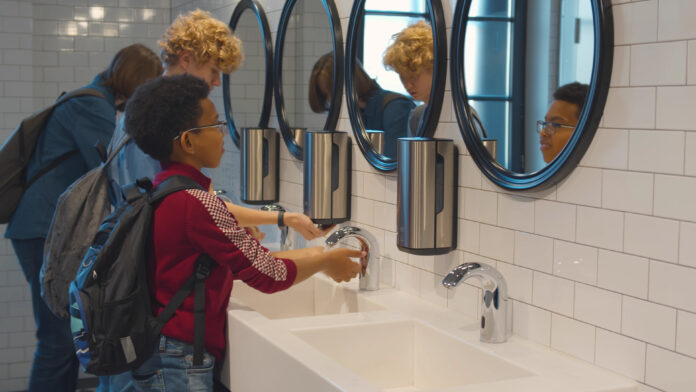
The cost and scarcity of water are becoming a growing concern. Commercial buildings, especially, can be major water users, accounting for up to 40% of a city’s water use. For this reason, introducing water efficiency measures is no excuse. By doing so, you’ll help conserve this valuable resource, save on cost, and improve the building’s performance.

Here are seven ways to improve water efficiency in commercial buildings:
1. Harvest Rainwater
Commercial buildings have a few distinct advantages when it comes to harvesting rainwater. For one, they tend to have large roofs that can catch water during a rainstorm. In addition, they often have gutters and downspouts that can channel the water into a storage container. And because businesses usually have a higher water demand than residences, they can use larger-scale rainwater harvesting systems.
There are many benefits to harvesting rainwater from a commercial building. Perhaps the most obvious advantage is that it can help save water during a drought. This can be vital for businesses that rely heavily on water for their operations.
Depending on the size of your commercial building, you can start by investing in a storage tank. A 30,000 liters tank, for example, can save up to 10,000 gallons of water during a 1-inch rainfall. You can explore more advanced options such as installing filtration systems to clean the harvested water for use in specific operations such as flushing toilets or irrigating landscaping.
2. Install Water Efficient Fixtures and Appliances
A commercial building can have a significant number of fixtures and appliances that use water, from toilets and urinals to dishwashers and laundry machines. Switching to more efficient models can make a big difference in reducing water usage. When switching, look for products with the WaterSense label, indicating that they have been certified water-efficient by the Environmental Protection Agency (EPA). In terms of toilets, for example, a WaterSense model can save up to 4,000 gallons of water per year compared to a standard one.
In addition to using efficient fixtures and appliances, you can reduce water usage by installing low-flow faucets and showerheads. While this move can lead to initial discomfort, it’ll ultimately result in a lower water bill for the building.
3. Conduct Regular Maintenance
Regular maintenance is essential for keeping commercial buildings water efficient. By checking for leaks and addressing them promptly, you can ensure that water isn’t being wasted. In addition, regularly inspecting plumbing fixtures and ensuring they’re in good working order can help reduce water usage. By taking these simple maintenance steps, you can help improve water efficiency in your commercial building.
4. Use Plants That Require Less Water For Landscaping
Introducing plants in offices is scientifically known to offer health benefits, among other perks. However, certain plants require more water than others to thrive. For example, cacti and succulents require much less water compared to flowers like hydrangeas. Therefore, switching to drought-resistant plants can significantly reduce water usage in commercial buildings.
5. Implement Greywater Recycling And Reusing
Recycling and reusing greywater (wastewater from showers, washing machines, and sinks) has become more popular as a way to conserve water in commercial buildings. If you thought this could only happen in a home setting, think again.
Many commercial buildings have started implementing greywater recycling systems and using recycled water for toilet flushing, irrigation, and even cooling towers. So, if your commercial building doesn’t already have a greywater recycling system in place, consider investing in one to reduce your water usage.
6. Introduce Digital Devices That Helps Lower Water Usage
In a world where technology is taking almost every industry, there’s no harm in utilizing it to reduce water usage in commercial buildings. For instance, installing bathroom sensors can prevent water from running endlessly if someone forgets to turn off the tap. Additionally, digital devices such as smart irrigation controllers can help control watering times for landscaping and automatically adjust depending on weather conditions.
7. Educate Your Tenants And Guests About Water Conservation
While installing low-flow appliances, harvesting rainwater, and gray recycling water can bring a difference in the figures that appear on your water bill, all can be a waste of time and resources if your tenants and guests aren’t aware of the importance of conserving water. Why? They may simply leave the tap running while brushing their teeth or take long showers without thinking twice.
Therefore, if you want a better financial future for your commercial building, start by educating your tenants and guests about their responsibility in conserving water. This can be done through informative emails or posters, training sessions, or providing tips on saving water in the building’s newsletter.
Final Thoughts
Water is a precious resource, and commercial buildings must take steps toward improving water efficiency. By incorporating these seven tips, not only will you conserve water, but you’ll also save money on water bills in the long run.

















